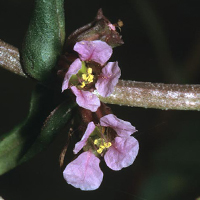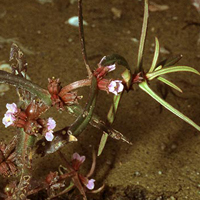Scarlet ammannia
Scientific name: Ammannia robusta


Cover photos credit: Allen Woodliffe (all photos)
Status
Endangered
"Endangered" means the species lives in the wild in Ontario but is facing imminent extinction or extirpation.
Date added to the Species at Risk in Ontario List
The Scarlet ammannia was already assessed as endangered when the Endangered Species Act took effect in 2008.
What it looks like
Scarlet ammannia is an annual plant that grows up to a metre high. Plants may branch, with the lowest pair of branches arising from the base and growing almost as long as the main stem.
It has 1.5 to eight centimetre long, narrow but rather thick and fleshy leaves, usually with basal lobes that clasp the stem. A member of the loosestrife family, it produces tiny lavender-coloured flowers, one to three of which develop at each axil (where the leaf joins the stem).
Where it lives
In Ontario, Scarlet ammannia is found on mudflats, sand beaches, and the edges of wetlands and ponds that are seasonally flooded. Fluctuating water levels are important to its survival.
It does well in habitat that is generally submerged early in the year and when water levels recede later in the summer the plants emerge.
Where it’s been found in Ontario
Scarlet ammannia ranges from south central British Columbia southward to Central America, and eastward through the United States to Ohio and southwestern Ontario in the north, and Tennessee in the south.
It is not found on the eastern coast of North America, with the exception of New Jersey where it is considered non-native.
View a larger version of this map (PDF)
What threatens it
The threats to Scarlet ammannia in Ontario arise from changes to water levels in the Great Lakes, wetland drainage, succession by woody plant species and housing development.
Invasive plant species, such as European common reed, also pose a threat.
Action we are taking
Endangered Species and their general habitat are automatically protected.
Recovery strategy
A recovery strategy advises the ministry on ways to ensure healthy numbers of the species return to Ontario.
Read the executive summary and full document (June 15, 2017)
Government response statement
A government response statement outlines the actions the government intends to take or support to help recover the species.
Read the government response statement (February 27, 2018)
Review of Progress
A review of progress made toward protecting and recovering a species is required no later than the time specified in the species’ government response statement, or not later than five years after the government response statement is published if no time is specified.
Read the report on progress towards the protection and recovery of 11 species at risk, including Scarlet Ammannia(2023).
Habitat protection
General Habitat Protection - June 30, 2013
What you can do
Report a sighting
- Report a sighting of an endangered animal or plant to the Natural Heritage Information Centre. Photographs with specific locations or mapping coordinates are always helpful.
Volunteer
Volunteer with your local nature club or provincial park to participate in surveys or stewardship work focused on species at risk.
Be a good steward
- private land owners have a very important role to play in species recovery; if you find Scarlet ammannia on your land, you may be eligible for stewardship programs that support the protection and recovery of species at risk and their habitats
- invasive species seriously threaten many of Ontario’s species at risk; to learn what you can do to help reduce the threat of invasive species, visit:
Report illegal activity
Report any illegal activity related to plants and wildlife to
Quick facts
- Scarlet ammannia seeds are most likely self-pollinated with no dependence on insects
- in British Columbia, Scarlet ammannia is found alongside another species at risk, Toothcup (Rotala ramosior); while these species are also both found in Ontario, they do not occur together here
